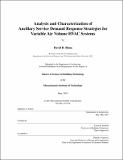Analysis and characterization of ancillary service demand response strategies for variable air volume HVAC systems
Author(s)
Blum, David H. (David Henry)
DownloadFull printable version (29.16Mb)
Other Contributors
Massachusetts Institute of Technology. Department of Architecture.
Advisor
Leslie K. Norford.
Terms of use
Metadata
Show full item recordAbstract
Output variability and prediction difficulties with respect to solar and wind electricity resources increase the requirement of grid-scale reserve capacity and add strain to existing firm generators used for reserves and other ancillary services. Residential and commercial buildings account for a large portion of the electricity consumed in the U.S. and can play a significant role in smart grids to help meet challenges brought about by intermittent renewable generation. High resolution power consumption and HVAC performance data measured in a real building was used to identify real-world operational qualities of VAV systems to be considered by building researchers and building practitioners. This includes the relative magnitude of building power loads, the direct and indirect relationships between environmental conditions and HVAC power consumption, the discrete operation of staged or cycled power loads, and the presence of HVAC operational faults. Also, three static pressure adjustment tests were performed over a one day period. Results showed that fan and terminal unit controllers responded within two minutes and system air flowrate was strongly related to power consumption. Dynamic models were created in order to simulate the performance of a VAV system providing spinning reserves by four different common demand response strategies: zone air dry bulb temperature setpoint adjustment (ZDBA), duct static pressure setpoint adjustment (SPA), supply air temperature adjustment (STA), and chilled water temperature adjustment (CWA). Simulations were run over ranges of implementation and cooling load intensities and the results were used to create characteristic curves for each strategy, which map performance in terms of system power consumption reduction, system airflow reduction, and zone temperature rise. Inflection points on the curves that delineate performance effectiveness are found to result from maximum or minimum terminal unit damper positions. In the future, the development of mathematical functional forms of these characterization curves could help predict and optimize the performance of VAV systems in providing ancillary services to electricity networks.
Description
Thesis (S.M. in Building Technology)--Massachusetts Institute of Technology, Dept. of Architecture, 2013. This electronic version was submitted by the student author. The certified thesis is available in the Institute Archives and Special Collections. Cataloged from student-submitted PDF version of thesis. Includes bibliographical references (p. 113-119).
Date issued
2013Department
Massachusetts Institute of Technology. Department of ArchitecturePublisher
Massachusetts Institute of Technology
Keywords
Architecture.